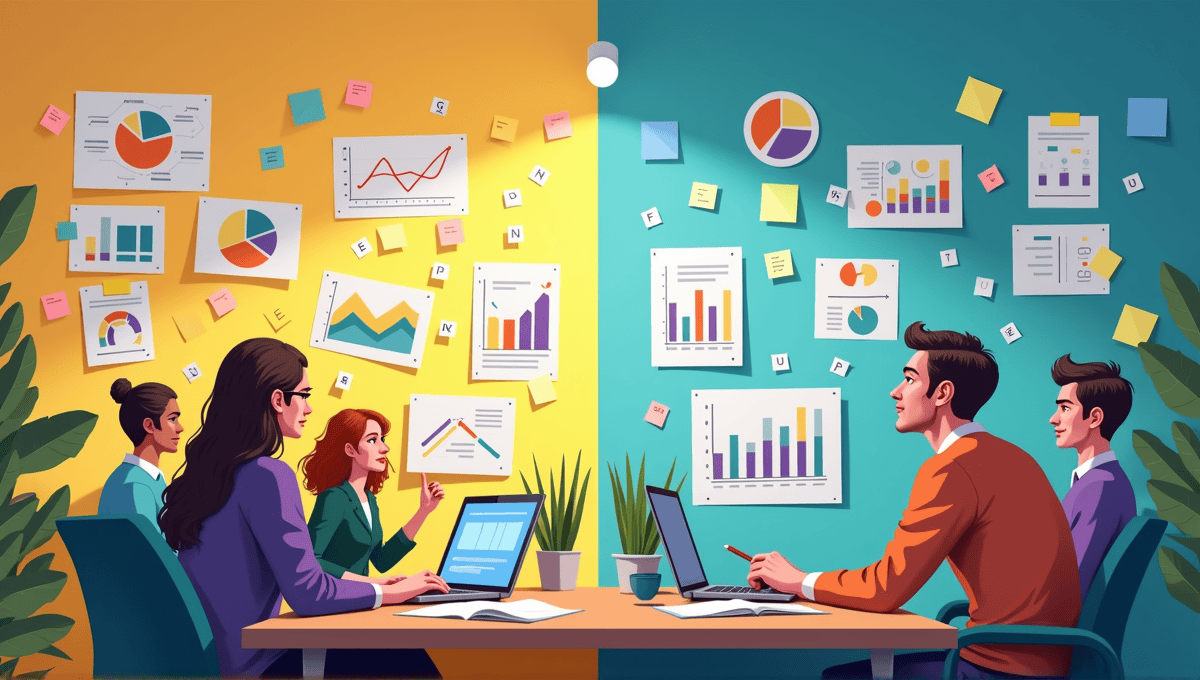Critical thinking barriers are simply obstacles that prevent us from thinking critically and solving problems analytically. I’ve seen these barriers stop projects dead in their tracks and prevent progress in manufacturing plants, so it’s important for anyone who is trying to optimize processes or make more data-driven decisions to be aware of these barriers. You’ll face things like cognitive biases, emotional influences, and simply not knowing the answer. Identifying these barriers is the first step to eliminating them.
Critical Thinking Barriers: Understanding Common Obstacles

Common barriers to critical thinking include:
- Cognitive biases
- Emotional influences
- Lack of information
- Societal pressures
- Personal assumptions
- Time constraints
- Logical fallacies
These barriers prevent us from thinking critically and from making better decisions or solving problems. They can cloud our judgment, limit our perspective, and prevent us from seeing key details. Identifying these barriers is the first step to overcoming them.
Cognitive Biases: The Mind’s Pitfalls
Cognitive biases are mental shortcuts the brain takes to process information more quickly. While shortcuts are efficient, they often cause errors in judgment. I’ve personally watched these biases ruin countless projects and decisions throughout my career.
One of the most common biases is confirmation bias, which is when we look for information that already supports what we believe. As a result, we fail to consider important data that contradicts our current thinking. When I was an hourly production worker, I realized how often we dismissed outside ideas that contradicted our typical processes.
Anchoring bias occurs when we rely too much on the first piece of information we heard. This can then impact how we interpret subsequent information. As a consultant, I commonly see initial cost estimates distort the negotiation process – even if that number isn’t actually relevant to the situation anymore.
The availability heuristic is when we overestimate the probability of events that we can quickly recall. Any events that just occurred or are still top of mind seem more likely than they actually are. This bias also frequently impacts risk assessments within manufacturing processes.
The Dunning-Kruger effect is when people overestimate their skill level in areas where they’re not actually skilled. I see this frequently when rolling out new systems. An employee who just learned a new skill will often think they’re now an expert.
Selective thinking is when we only consider evidence that supports what we initially believed. In turn, this reinforces confirmation bias and leads to flawed decision-making. I’ve sat in many boardrooms where executives cherry-pick stats to prove their point.
Emotional Influences on Critical Thinking
Emotions are one of the most significant factors that influence our thought process. They can prevent us from thinking clearly and cause us to make irrational decisions. Throughout my career, I’ve seen how emotions can derail even the best-planned projects.
Fear and anxiety are two of the biggest roadblocks to critical thinking. When people feel uncertain, they often avoid making any decisions at all. This can lead to missed opportunities or continued inefficiencies. I’ve seen entire production lines grind to a halt because the responsible team lead was afraid to suggest changes.
Anger often leads to making decisions you’ll regret later – when angry, you become more myopic and are more likely to lash out at others. In consulting, I’ve mediated conflicts where decisions made out of anger destroyed team relationships for years to come.
Emotional thinking occurs when you allow your feelings to overpower logic and reason. This results in making impulsive decisions that conflict with your goals and values. I’ve seen this in action when team members were emotionally attached to an outdated process and resisted a necessary change.
When critical thinking, managing your emotions is simple:
- Practice mindfulness.
- Step away when you feel overwhelmed.
- Ask neutral third-parties for their thoughts.
- Write down your thoughts to gain space from them.
Of course, emotions themselves are not a bad thing. They can also offer valuable intuition. The key lies in balancing emotional with logical thinking.
Lack of Information and Knowledge Gaps

It’s also incredibly risky to make decisions with an incomplete dataset. It feels like navigating a ship in the dark, with no chart to guide you. Maybe you’ll get lucky, but more likely than not, you’ll crash into something. I learned this lesson the hard way early in my career as a team leader when I made changes without knowing all of the information.
There is no better strategy than collecting data from as many sources as possible. If we can say that data came from three different sources, we all felt more confident in our decision. Feeling confident when there’s still risk involved is one of the main psychological components of an effective critical mindset.
Similarly, one of the top information barriers to critical thinking is not realizing you lack a piece of information. If you don’t know you’re missing a data point, how can you know to look for more information? I’ve solved this for myself in consulting by always beginning a project with a discussion about where we lack information.
Societal and Cultural Influences
Cultural influences play a major role in critical thinking. They define our initial assumptions and biases (many of which we don’t even realize we have). As I consult with international companies, I frequently notice how cultural variance leads to miscommunications and faulty analysis.
Groupthink occurs when the need for group harmony suppresses rational decision making. It causes the group to make suboptimal decisions and stifles creativity. I’ve observed this dynamic in corporate boardrooms where everyone feared speaking up with a dissenting opinion, and it led to a costly mistake.
Stereotypes and prejudices prevent you from analyzing a situation objectively. Instead, you may jump to unfounded conclusions about people or situations. This becomes a recurring theme in my work with diverse teams. Socentric thinking arises when you prioritize your social group over others. As a result, you conform to the beliefs of your in-group and treat outsiders with hostility. This behavior causes the group to overlook a potential opportunity or collaboration. Corporations lose market share when the entire organization is too focused on internal competition and forgets about the customer.
Overcoming society’s impact on critical thinking requires a deliberate choice. You have to be willing to question your initial assumptions and hear a perspective that’s different from your own. And if you can’t do that, you won’t be very effective at solving problems in today’s world, where our teams are now more global than ever.
Overcoming Personal Biases and Assumptions
Identifying and questioning personal biases is a key element of effective critical thinking. Your thoughts are a product of your experiences, which can be an asset, but it can also be a limitation. I’ve certainly had to address my own biases many times throughout my career.
Ways to overcome personal biases include:
- Seeking different opinions
- Engaging in discussions
- Reading about a wide range of topics
- Traveling and experiencing new cultures
Self-awareness is another key aspect of improving critical thinking. You should regularly analyze your thoughts and how you make decisions. Ask yourself why you believe the things you do and if it’s for a good reason.
We’re all naturally prone to egocentric thinking. We all naturally see the world from our own perspective. As a result, we often interpret information in a way that benefits us and struggle to see a different perspective. Overcoming egocentric thinking requires consciously stepping outside of your own perspective and considering another view.
Ways to reduce egocentric thinking include:
- Listening to others
- Empathizing with others
- Thinking about how other people feel as a result of your actions
- Asking for people’s opinions about your ideas and decisions
Remember, overcoming personal biases is an ongoing challenge. It takes constant effort and a willingness to admit when you’re wrong.
Time Constraints and Pressure

I’ve witnessed numerous projects go off the rails because of a quick decision made under time pressure. For example, in manufacturing, the desire to move quickly often results in insufficient analysis, which eventually backfires when a mistake is made.
Strategies to think efficiently under time constraints include:
- Identifying the most important information.
- Using decision-making frameworks.
- Delegating.
- Taking a quick break.
Learning to make fast decisions without analysis comes with experience. You need to develop a sense of when you should invest more time in analysis and when to rely on your intuition. In consulting, I often work with teams to develop decision-making frameworks for various situations.
Short-term thinking is when you only think about what needs to be done now. This often results in quick decisions that solve today’s problem but create a larger issue down the road. I’ve seen this problem when companies prioritize quarterly results over long-term growth.
Ways to manage stress in time-sensitive situations include:
- Deep breathing.
- Breaking a task into smaller tasks.
- Keeping your workspace clean.
- Talking about the problem with someone else.
And remember, if you need more time to make a decision when you feel stressed, often the correct decision is to buy more time. Ask for an extension, delay the decision, and go back to other ways to grow the business.
Logical Fallacies: Traps in Reasoning
Logical fallacies are flaws in reasoning that can cause an argument to reach an incorrect conclusion. They’re often quite persuasive at first glance, which is why logical fallacies are so dangerous. I’ve seen how logical fallacies can derail a conversation and lead to poor decisions throughout my career.
Common logical fallacies include:
| Fallacy | Description |
|---|---|
| Ad Hominem | Attacking the person instead of the argument |
| Straw Man | Distorting an opposing argument to make it easier to knock down |
| False Dichotomy | Offering only two choices (when others exist) |
| Slippery Slope | Assuming one small action will lead to many next steps |
| Appeal to Authority | Arguing something is true because an expert said it |
Spotting fallacious arguments comes with practice and being diligent. Look for patterns and of course, always challenge an argument. In my consulting work, I often encourage teams to respectfully question one another’s logic.
Logical fallacies are more prevalent in everyday life than you might realize. Advertisers use them to persuade consumers. Politicians use them in debates. Even in casual conversation, we can sometimes spot these errors.
To avoid using logical fallacies in your thinking:
- Challenge your assumptions.
- Look for evidence backing an argument.
- Consider other possible reasons.
- Be okay with being wrong.
Learning this skill takes time, but it’s one of the most important critical thinking and decision-making skills you can develop.
Developing Critical Thinking Skills
Improving analytical thinking skills is something that takes daily practice. You can’t just decide to be a better critical thinker and make it happen. When I look back at my career, I’ve always been practicing these skills, and I’ve always been analyzing things. I think you’ll find that to be the case if you talk to other successful human beings. Therefore, I’ve chosen exercises throughout my career designed to improve these skills.
Exercises to improve analytical thinking skills:
- Solve logic problems.
- Analyze case studies.
- Participate in a structured debate.
- Practice mindfulness through meditation.
- Write in a reflective journal.
As you might expect, asking questions is fundamental to developing critical thinking. Therefore, teach yourself to ask more questions that challenge assumptions and dig deeper into an issue. Probably 80% of my consulting work involves teaching a team how to ask better questions.
The most basic thinking error is when someone oversimplifies a complex issue. This often happens when people make a hasty generalization or stereotype somebody. Therefore, practice breaking down complex problems into smaller parts you can solve. I also love that it keeps people from getting so locked into their own perspective on an issue.
Resources for deeper learning and building the skill further:
- Online course on logic and critical thinking.
- Books on cognitive biases and decision making.
- Professional development events.
- A mentorship program.
Always remember that becoming a good critical thinker is a lifelong journey. So, stay curious, always be open to new ideas, and always be asking questions. Then, use those questions throughout all areas of your life, from personal relationships to your professional career.
When dealing with complex problems, it’s often helpful to use structured problem-solving methods. One such method is 8D problem solving, which provides a systematic approach to identifying and resolving issues.
To Conclude
Critical thinking barriers impact our decision making and problem-solving skills. Many of these barriers are subconscious, from cognitive biases to emotional factors. Therefore, awareness of these barriers and how to address them is essential to think more effectively. By understanding problems such as confirmation bias, time constraints, and social biases, we can then develop tactics to overcome them. Improving your critical thinking skills takes deliberate practice, introspection, and the ability to question your own beliefs. Don’t forget it’s a journey, so continue applying and refining these skills to think through more complex problems.






